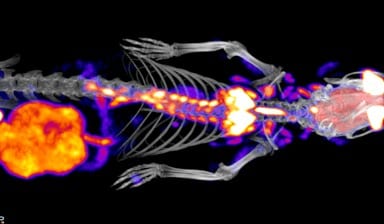1. What is PET/CT Imaging?
PET/CT imaging is the combination of two distinct imaging techniques
2. What is PET Imaging?
PET, or positron emission tomography, is a look at the metabolic or biochemical activity present in a given anatomical region using radiotracers.
3. What is a radiotracer?
A radiotracer is a chemical compound in which atoms have been replaced by a radionuclide. After undergoing normal radioactive decay, the path the radiotracer takes can be traced, from reactants to products. Essentially, a radiotracer allows for the visualization of chemical processes within the body. Radiotracers of carbon, phosphorus, nitrogen, oxygen, fluorine, and sulfur are the most common.
a
4. What is CT imaging?
Computed tomography, or CT, imaging combines X-ray images taken of the body at different angles to create cross sectional images of the bones, blood vessels, and soft tissues inside the body. CT scans allow medical professionals to view parts of the body in individual slices.
a
5. What is spatial resolution?
In PET/CT Imaging, spatial resolution refers to the quality of the image due to the equipment. Factors affecting spatial resolution include:
- Size of detector used- each detector defines a channel. The width of each channel is typically 0.4-0.6 cm based on the detectors used. The Sedecal SuperArgus PET/CT offered by Scintica Instrumentation uses LYSO crystals which have been shown to offer the best light emission performance with GSO crystals being a close runner up. The SuperArgus offers both and, therefore, offers an advantage over other options.
- Collinearity or noncollinearity of annihilating photons
- Range of emitted positrons
6. What is FOV?a
The field of view (FOV) is the maximum diameter of the area of the scanned object that is represented in the reconstructed image. Therefore, the bigger the FOV, the more of an animal can be captured in a single image.
a
7. What is sensitivity?
Sensitivity in a PET image refers to its ability to accurately replicate and maintain true likeness of the biochemical or metabolic activity happening within the body. The higher the percentage, the more sensitive an image is.
- Sensitivity is increased with the addition of simultaneous CT scanning
- Sensitivity is increased with the addition of certain radiotracers
- Sensitivity is increased with the use of a fully body scan versus a partial anatomical scan
a
8. Suggestions for future reading:
Generalized understanding of PET/CT Imaging
Comparative evaluation of crystal scintillators (detectors)
Keywords: mouse, mice, rat, rats, small animal, small animals, rodent, rodents, imaging, small animal imaging, solution, solutions, research,
To learn more about our PET/CT option click here
